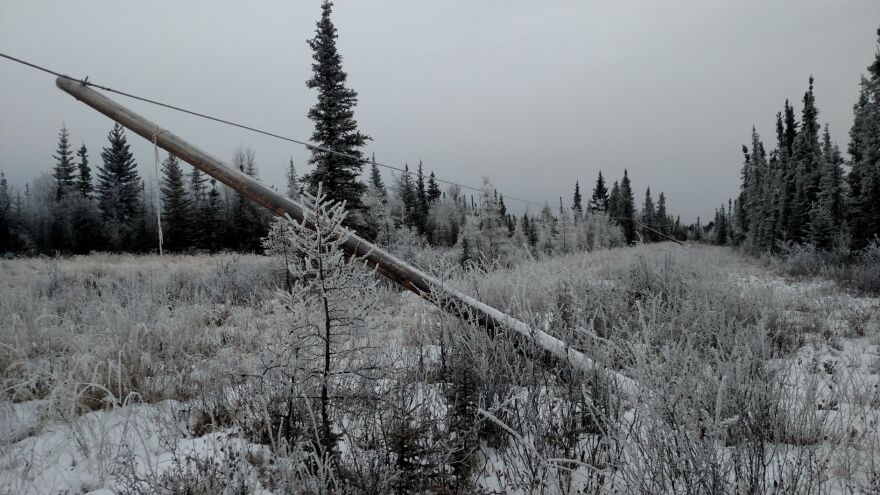Alaska Communications is planning to repair or replace about 20 telephone poles that are slowly falling over along a swampy stretch of the Richardson Highway north of Delta Junction. It’s a recurring problem that Alaska telecoms have dealt with for years. And there’s concern that climate change is likely to make it worse in the years ahead.
The tilted telephone poles that Alaska Communications will replace this spring run through a stretch of the Shaw Creek Flats about 20 miles north of Delta Junction. Some lean slightly, while others are tilted so much they’re only within a few feet from falling over.
“As poles tilt, we plan to either repair or replace them,” says Alaska Communications spokeswoman Heather Cavanaugh. The leaning poles don’t cause connectivity problems, she said, but the company sometimes replaces them just because they look like they’re not well-maintained.
“And of course, where we can, we remove the poles and update our network with fiber and then move everything underground,” Cavanaugh said.
Telecom-industry spokeswoman Christine O’Connor says burying fiber-optic cable is expensive, unless it’s be done when other utility lines have to be laid in the same area.
“If you’re digging a trench to put in other utilities,” she said, “then you can share that efficiency of the cost of the trench to put in, say, your electric and your telecom infrastructure.”
A fiber-optic cable was buried a couple of years ago near the Alaska Communications’ poles around Shaw Creek. But Cavanaugh says that line is for internet connectivity, and the phone lines are used for voice. She says company officials have decided to now repair or replace the leaning poles in the area. She says Alaska Communications spends about $35 million annually in upgrading and maintaining its system. And most of the dollars to fix leaning poles will go to fix trouble spots in the Interior.
“Right now, the biggest area we’re focused on is in the Fairbanks area,” Cavanaugh said. “And then we do have a handful of poles on the Kenai Peninsula that are leaning that we plan to again replace or repair.”

O’Connor is executive director of the Alaska Telecom Association, and she says maintaining telephone poles in remote and rugged areas around Alaska is a costly but unavoidable necessity.
“If you’re dealing in say with rocky areas in Southeast or muskeg or tundra or permafrost – (there are) a lot of different situations,” she said.
University of Alaska Fairbanks researchers suspect warming has thawed permafrost more deeply under the Shaw Creek Flats and made the area more swampy. But Cavanaugh says Alaska Communications sees no evidence that it’s a factor there.
“We do have permafrost and swampy land in Alaska. We always have,” she said. “And so, it’s an issue that we’ve always dealt with.”
O’Connor says she hasn’t heard concerns from Alaska telecom-industry officials that climate change will require more telephone-pole maintenance in the years ahead. She says regardless, they’ll continue to closely monitor permafrost and the telephone poles that run through it.
Editor's note: This story has been revised to clarify that the majority of Alaska Communications' maintenance funding for repairing or replacing leaning telephone poles will be directed to the Interior.



